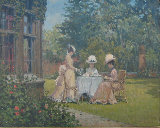-

-
Albert Whitlock
United KingdomArt Brokerage: Albert J. Whitlock British-American Artist: b. 1915-1999. Albert J. Whitlock was an British-born motion picture matte artist best known for his work with Disney and Universal Studios. His film career began as a page at Gaumont Studios in London in 1929, before going on to build sets and work as a grip. Trained as a sign painter, he began a life-long association with Alfred Hitchcock, completing all of the signs for The 39 Steps and then assisting in the miniature effects for The Man Who Knew Too Much. Whitlock began working as a matte artist during World War II. Recruited by Walt Disney, who was an admirer of his work, he would relocate to the U.S. in the early 1950s. At Disney, where the head of the Matte Department was fellow-Londoner and near-exact contemporary Peter Ellenshaw, he successfully mastered the impressionistic approach to matte painting that he would become known for. He remained with the studio for seven years, helping with the design of Disneyland as well as film work, before moving to Universal in 1961. There he served as the head of their matte department, continuing his long collaboration with Alfred Hitchcock and many other directors, until retiring from the company in 1985 (though he continued to work on the odd production for a few years after). His crowning achievement was the creation of over 70 individual matte paintings for the 1974 disaster film, Earthquake, which earned him an Academy Award. He won the Oscar again the following year for The Hindenburg, in which he re-created the great airship and its final voyage. Universal loaned out Whitlock and his team for some notable visual effects work on films including Greystoke: The Legend of Tarzan, Lord of the Apes, the David Lynch version of Dune, Mame, The Learning Tree and Bound for Glory. In the latter film, Whitlock created the famous Dust Storm with moving cotton-covered disks. In addition to his film work, Whitlock is famous among Star Trek fans for the matte painting used to establish the huge exterior of the Delta Vega lithium cracking station in Star Trek (1966). The painting was later modified and reused as the Tantalus penal colony from the Star Trek episode "Dagger of the Mind." Decades later, this recycled shot was replaced with a digital background newly created in 2007 for the remastered edition of the episode. Whitlock was also responsible for the matte paintings in History of the World, Part I, and appeared in the movie as a character hawking used chariots. He also produced background mattes for Brooks earlier film High Anxiety, and appeared in that film in a small role as "noted industrialist Arthur Brisbane." Whitlock was honored with the following awards: 1975: Academy Award for Special Achievement in Visual Effects in Earthquake (shared with Frank Brendel, Glen Robinson) 1976: Academy Award for Special Achievement in Visual Effects in The Hindenburg (shared with Glen Robinson) 1985: Emmy for Outstanding Special Visual Effects in A.D. shared with Syd Dutton, Mark Whitlock, Bill Taylor, Dennis Glouner, Lynn Ledgerwood).
Read More + - Create Listing 0 Artworks for sale 7 Followers
-
We are actively seeking listings for Albert Whitlock.
Create a free listing or free wanted ad.
-
Art Wanted
We have interested buyers looking for these artworks by Albert Whitlock:
- CREATE AD
- Art Brokerage Requests (1)







































